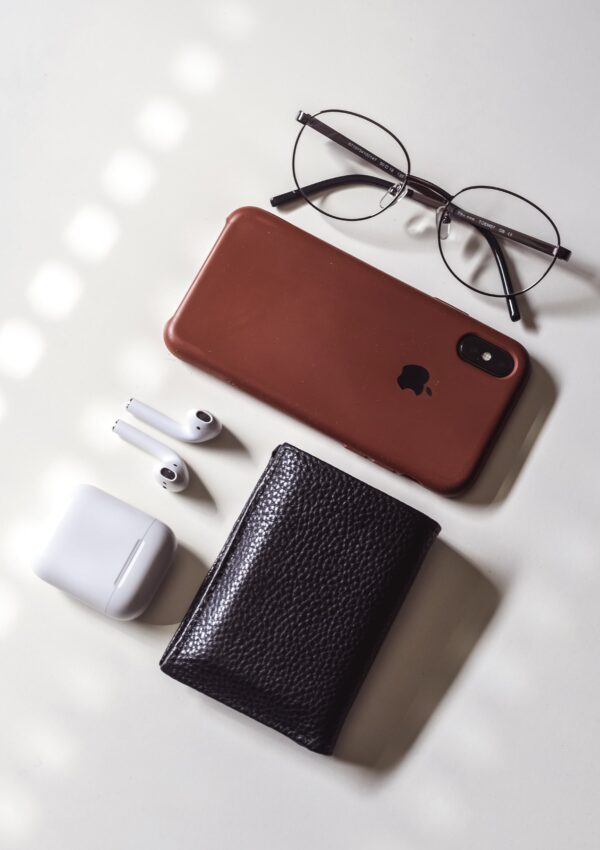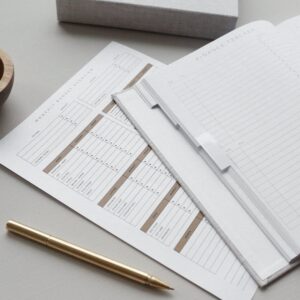Learning to budget can significantly improve your life.
How would you like to be able to go on more vacations? Buy healthier foods? Buy more books? Go to the gym you really want to go to? Retire early?
A budget is the main way to reach goals like these and more.
While many view budgeting as something that stands in the way of freedom, it is just the opposite.
A budget is a tool to help you reach your money goals.
If you don’t like the word budget, you can also think of it as a spending plan.

Think about Your Goals.
Think about Your Goals
The first step of budgeting is to answer the question: what are you trying to accomplish?
This could be as simple as saving for a really cool trip.
Or it could be as complex as knowing you need to make a career shift to reduce stress, and needing to be able to take a temporary pay cut to start over in a new field.
Creating a spending plan can give you the freedom to do that.
Spend some time brainstorming and answering the ‘why’ behind your budget.
Learning to budget starts with financial goals that resonate with you.
These goals will help you stick to it.
Track Your Spending
The next step is tracking your spending. Note where your money is going.
- What is your total weekly spending?
- Total monthly spending?
This includes all static and fluid bills, debt, and lifestyle expenses–the granola bar at the gas station, the afternoon coffee, the pack of gum. Note it all.
Finding the best way to track your spending doesn’t have to be complex.
You can use pen and paper, use an app that auto tracks for you, or use a spreadsheet.
Choose a method of tracking that will help you be consistent.
Learning to budget starts with being aware of where your money is going.
Note Your Income
How much money do you bring in a month?
This number will be the after tax, after insurance, and after any retirement contributions number.
The amount of your check each pay period.
Now, find the difference between your income and your spending.
This number is the starting point for creating a budget.
It represents what your savings rate is and gives you the details to make adjustments.
In our vacation example, say you want to go on a trip to Europe in 10 months. If the trip costs $3,000 you’ll now know how much you’ll need to cut spending to create an excess of 3k by the time of the trip.
In our career change example, say your bills and spending are already close to your total income. You’ll need to lower spending to fit within the projected income of the new job in order to live comfortably while reducing the stress in your life and taking that pay cut.
Learning to budget is based on your current savings rate and the rate you are aiming to hit.
Review Spending
Review your monthly spending and group it into categories.
The categories should immediately help you know what areas could stand to be limited.
In your initial review, it is important to see things with a realistic eye, as well as an eye for sustainability.
A few things to consider:
- What were the highest categories?
- What categories brought you the most joy?
Note the Highest Categories
Pay attention to the areas of spending that were higher than you thought.
Would you miss anything if you cut those areas by 25%? What about 50%?
Keep your financial goals in mind when assessing categories.
Specifically, note the timeline of your goals, as a timeline can help set category amounts.
A timeline is a way of starting with the end in mind. It gives the framework for a goal and can help you work backwards to the savings amount you need to hit.
Note What Made You Happiest
Now, note the spending that made you the most satisfied.
Would that same type of spending make you as happy the 2nd or 3rd time you spent that amount?
It’s important to keep the habits that make us happy to the degree that happiness is maximized.
This will largely make your new spending plan sustainable, as it leaves room for things you enjoy.
For instance, I enjoy lattes. A good oat milk latte is a happy time for me. It’s a time to catch up with a friend or spend a morning writing in a new space. The 2nd latte in the month makes me just as happy, but the 3rd or 4th latte definitely drops in the happiness levels for me.
This is mainly because my enjoyment for the 3rd or 4th latte doesn’t outdo the $5.50 I pay. Instead, I become keenly aware that I am leveraging my other goals for that small enjoyment, thus rendering it less enjoyable.
For me, it’s about finding the sweet spot of enjoyment and my goals.
Learning to budget involves simple tracking and goal-setting, but it also involves getting to know yourself better and allowing yourself to enjoy the fun things in life, just to a more intentional degree.
If You Do Nothing Else Do This – Emergency Fund
Building an emergency fund is a prerequisite of budgeting.
Start with $1,000 set aside for times of emergency. The goal is to build that amount to 6 months of bills and expenses necessary to live set aside for unprecedented emergencies that can come up and put you in a bad place.
Emergency funds are a way to insure your lifestyle and be prepared for the unforeseen circumstances that come up. We can’t know the future, but we can know that it is reasonable to have money set aside to pay our bills and continue to live our life when hard times come.
And they will almost inevitably come. There’s no doubt about that.
As you tackle learning to create a spending plan, it’s a good idea to pause any excess spending until you have a few thousand dollars set aside for emergencies.
Think of this number as your zero.
An emergency fund should be a part of every week’s budget.
Once you have a few thousand dollars set aside from a focused period of saving, you can integrate continuing to add to your emergency fund through your budget. Make these set contributions consistently until the emergency fund reaches the amount equivalent to 6 months of spending.
I like to base emergency funds on my current lifestyle spending. Having 6 months of that spending set aside could realistically be stretched to cover more than 6 months in a real emergency situation, as I would certainly adjust my spending to only the most necessary things.
3 Types of Budgets to Consider when Learning to Budget
With your goals and current savings rate in mind, it’s time to create a budget.
Learning to budget is a habit that will only get better with experience.
Trial and error is your teacher, especially when it comes to something as personal as personal finance.
Three types of budgets to consider and try include:
- Use a popular budget template like the 50/30/20 rule
- Set up limits for each category of spending based on lifestyle and goals
- Only limit spending in categories that have the potential to exceed reasonable amounts
50/30/20
Using a popular budget template like the 50/30/20 rule is a quick place to start.
This rule is simple in that it divides money into three main categories and uses percentages to dictate set amounts vs. itemizing categories and setting individual limits to each category.
The 50/30/20 rule involves putting 50% of income towards life necessities, 30% towards wants, and 20% towards savings.
Pros
- Simple to understand and apply
- Not a ton to calculate and nit pick.
Cons
- Can be difficult to implement at first because it assumes 20% excess for savings.
- As a result, this approach won’t really help you work your way to an attainable plan
Use the basic principles of dividing money in three large categories and enjoy the simplicity of setting category limits based on gross percentages. You can also adjust the percentages of each category as needed.
Personalized Budget
Going the personalized budget route does involve a little more leg work.
With this method, setting category limits can be determined in a variety of different ways.
- You can start with your end savings goal and work backwards
- You can set category limits based on what you think is reasonable and work forward
- You can start with what you have and slowly lower your spending in each category and work your way to your goal
The variables with this method are endless and can be easily captured in a spreadsheet.
Pros
- The personalized budget allows the most customization.
- It also allows you to stair step your way towards your goals
- Being this meticulous will help you really pay attention to where your money is going and give you a clear idea of what is needed.
- It can also serve to break the process down into manageable pieces.
Cons
- The start-up cost is extremely high. It is a complex and customized method that has a higher barrier to entry than most things.
- This can be quite a time drain when it comes to the setup and maintenance.
There are apps and free spreadsheets out there to get started with, however. So, don’t be discouraged, even Google Docs has budgeting templates that you can use and adjust based on your needs.
Hybrid Budgeting
This is the method that I like to use at the moment.
The main principle is setting budgeted amounts for categories that largely exceed reasonable spending or have the potential to exceed reasonable spending.
For instance, no one ever really spends too much money buying too much toilet bowl cleaner, paper towels, or oil changes. At least in our household we don’t.
On the other hand, travel, groceries, eating out, buying clothes, etc. all have the possibility of exceeding a reasonable amount each month or year.
The reasonable amount here is the amount you set with your goals in mind.
Pros
- This method is practical and only requires budgeting in certain areas.
- It is more time friendly and easy to set up and maintain.
- It is very specific to your goals.
Cons
- This method isn’t an overall budget method and does leave room for overspending if you’re more of an all or nothing type of person. In essence, it can be too lazy of an approach for some to get onboard with.
Review and Adjust
A budget should be designed to serve you and your goals.
The final and ongoing step of learning to budget is reviewing what you have and making adjustments. The tool you create is not going to be perfect at first. And, even if it is, you expect life changes along the way that will require adjustments.
Set up some time to review your budget weekly or monthly and adjust as you go.
This process of close review and small adjustments is the most instructive phase in creating a lasting tool that actually helps you the way you want it to help you.
This process will also help you define your money philosophy.
To borrow from Ramit Sethi, he calls this philosophy living your ‘rich life’. In my latte example, setting aside coffee money would be part of my rich life. In essence, your rich life means prioritizing the things you enjoy and approaching your finances the way that makes sense to you.
Determining how to handle your finances is extremely personal.
Building a budget is not something that simply mirrors what others do. It is building a method that serves you and what you like to prioritize.
Pay Yourself First
Paying yourself first is a main principle in the book The Richest Man in Babylon.
The saying represents a perspective shift.
When it comes to budgeting and money management, paying yourself first is about prioritizing yourself before other things. We save and invest to prioritize freedom later on in life, we save to ensure our lifestyle when hard times inevitably come. We prioritize these things over our bills every month.
This is not to say you pay yourself before you pay your bills. It is about being responsible to pay the bills that you owe and not forgetting to be responsible to yourself now and in the future.
Setting up a money habit like budgeting should be realistic and sustainable so that the plan plays out over a long period of time. The goal is to get this new habit to stick around.
Being realistic and sustainable with your money goals also means setting aside amounts for personal spending enjoyment.
A budget doesn’t mean all sacrifice and no fun.
Make sure to set up a sort of allowance for yourself to be able to have and spend on whatever you want. This amount should be reasonable and in line with your overall goals, of course, but it is a set aside amount that is totally up to you to decide how to spend.
Maintaining an area of freedom in your budget will help you budget the things you want, firstly, but it will also allow you to not feel completely stifled.
Staying on track goes hand in hand with creating something attainable. Don’t expect to limit every area of your life and stick to it.
Budgeting like many other things in life is about small choices over time, not overnight changes. Similar to changing eating habits, we can’t wake up one morning and think we will make perfect choices in every area all at once.
Let the Budget Work for You
Once you create a budget that is reliable and sustainable, it’s time to let it work for you.
It’s a lot of leg work in the beginning, but once a consistent plan is set up, it is time to let the process work for you.
You can also automate the process as much as possible with direct deposit, auto pay, and apps that help you track your spending.
Learning to budget is an ongoing process, but once the initial work is done, it’s easy to be in the habit and let it work for you.



